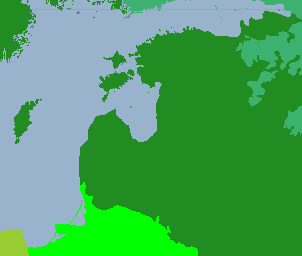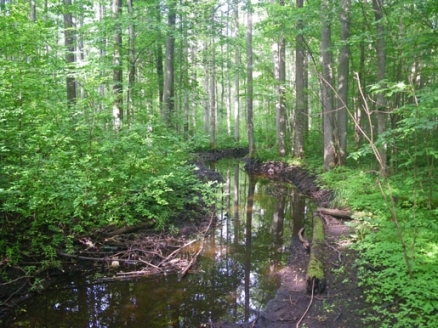Ecoregions of Estonia
Contents
Ecoregions of Estonia
Ecoregions of Estonia are described by a single ecoregion, the Sarmatic mixed forests. These forests have been greatly decimated, especially over the last two millennia, due chiefly to agricultural conversion of natural landscapes. The Sarmatic forests typically are found quite close to the coastlines of Estonia along the Baltic Sea, with relatively little backshore, dunes or other intervening ecosystems. The Sarmatic forests of Estonia are topographically relatively low lying, with some of the near coastal instances having ancient dune-like terrain long covered with forest detritus derived soils. These undulating formations also create interesting bog-type interludes within the forests, rich in ferns, sundews and other marsh flora.
Sarmatic mixed forests
 Sarmatic mixed forests (dark green) cover Estonia. Source: WWF
Sarmatic mixed forests (dark green) cover Estonia. Source: WWF
See main article: Sarmatic mixed forests
The Sarmatic mixed forests are comprised of a mixed conifer broadleaf plant association dominated by Norway spruce (Picea abies) and Scots pine (pinus sylvestris) with some broadleaf admixture, especially oak species such as Quercus robur in the north.
In addition to the dominant canopy, there are a number of shrubs, wildflowers, grasses and mosses that inhabit the mid-tier and forest floor. Common low-growing shrubs include Bilberry (Vaccinium myrtillus) and Heather (Calluna vulgaris). Example forbs seen in the forest understory include Common Spotted Orchid (Dactylorhiza fuchsii), Red Campion (Silene dioica), White Campion (Silene latifolia ssp. alba), Sand Catchfly (Silene conica), Field Scabious (Knautia arvensis) and Marsh Helleborine (Epipactis palustris). In some fens within forest clearings the Marsh thistle (Cirsium palustre) is found.
The Alam-Pedja wetlands of Estonia support ospreys, white-tailed eagles, Eurasian cranes, and numerous songbirds. The European white stork (Ciconia ciconia) has breeding areas at the fringes of many of Estonia's Sarmatic forests, especially in rural areas, where there is a presence of man; this bird is one of the few species in nature that is not only habituated to humans, but uses structures made by man such as chimneys and utility poles for nesting sites.
Structural definition of ecoregions
Ecoregions are areas that: [1] share a large majority of their species and ecological dynamics; [2] share similar environmental conditions; and, [3] interact ecologically in ways that are critical for their long-term persistence. Scientists at the World Wildlife Fund (WWF), have established a classification system that divides the world in 867 terrestrial ecoregions, 426 freshwater ecoregions and 229 marine ecoregions that reflect the distribution of a broad range of fauna and flora across the Earth.
References
- U.G.Bolub Bohn and C. Hettwer. 2000. Reduced general map of the natural vegetation of Europe. 1:10,000,000. Bonn-Bad Godesberg, Bonn.
- C.Michael Hogan. 2009. Marsh Thistle: Cirsium palustre. GlobalTwitcher.com, ed. N.Strömberg.
- H.Sjors. 1999. Swedish plant geography: The background: Geology, climate and zonation. Acta Phytogeogr. Suec. Uppsala: Opulus press, 84:5-14.
- S.F.Kurnaev. 1973. Forest regionalization of the USSR. Nauka, Moscow Russian.
- World Wildlife Fund. 2001. Sarmatic mixed forests. (PA0436).
